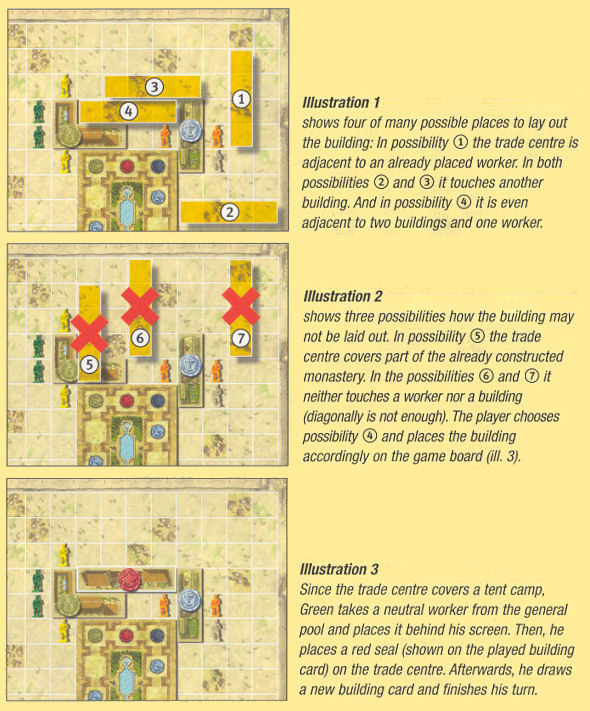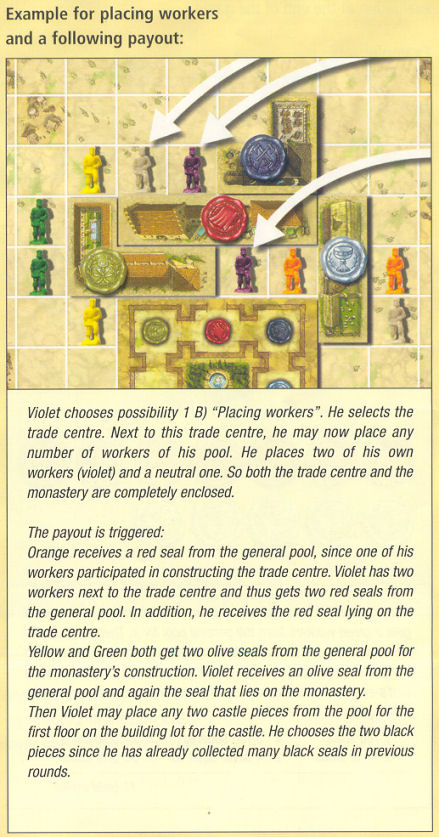In a remote land there lies a region with undulating hills and fertile valleys. Widely-travelled settlers have laid the foundation stone for the city of Arkadia. In addition to several other buildings they want to construct a magnificent castle on a hill. Four wealthy families - the cloth merchants, the spice merchants, the carpenters and the silversmiths - want to enhance prestige and augment their influence. For this reason, they compete for the major contribution to the castle's construction. Players act as architects. The four families commission them to plan and realize the build-up of the town and the castle.
Aim of the Game
Players build buildings and the central castle in the town of Arkadia. For constructing buildings they get seals of the four families. Whenever a building is completed, castle construction is continued. Subject to the family's contribution to the castle construction, the value of the family's seal changes. In the course of the game, each player can convert his seals into gold - he may decide when to do this himself. The player with the most gold wins the game.
How to Play
A player's turn is divided into two parts:
- MUST
The player takes one of the following actions:
- Play a building card and place the corresponding building, or
- Place one or more workers
- CAN
Afterwards, the player may play one of his architect banners.
Details of the actions:
1. MUST
A. Place a building
The player chooses a building card from his hand and places the building shown on the card so that the building is horizontally or vertically adjacent to any building or worker already placed or to the building lot for the castle.
The squares covered by the building must be vacant, that is without any other building or worker on it.
A seal of the color shown on the building card is placed on the building. The seal indicates that the building is still under construction and which family has placed the order.
The played building card is discarded and is out of the game. Then the player adds a new card to his hand so that he has four cards again. He either chooses one of the three face-up cards or draws the top card from the face-down stack. If the player chooses one of the three face-up cards, it is replaced by the top card in the stack. If all cards have been taken then the player continues his turn without taking a card.
Neutral workers:
Some squares on the game board show tent camps in which players can recruit migrant (= neutral) workers. These tent camps are not considered to be buildings, so they can be covered by a building. If a player places a building on one or more tent camps, he gets one neutral worker for each tent camp covered by the building.
Example for placing a building (see illustrations below):
Green plays a building card that shows a trade centre and the cloth merchants' red seal. Green takes a trade centre from the pool and places it on the game board.

B. Place one or more workers
The player chooses any building on the game board. He places any number of his own colored and neutral workers on vacant squares that are horizontally or vertically adjacent to the building, one worker per square. All workers that a player places during his turn have to be adjacent to the same building. Once a worker has been placed on the board, it remains on the square for the rest of the game. A worker is never moved or removed.
Note: A player does not get a neutral worker for placing a worker on a tent camp.
A building is completed:
A building is completed when all horizontally and vertically adjacent squares become occupied by workers or other buildings. Completing a building by placing a building or workers triggers the payout and the continuation of castle construction.
Payout: All players who have placed workers next to the completed building receive seals. For each of his colored workers that is horizontally or vertically adjacent to the completed building, the player gets a seal of the color of the seal lying on the building. The player whose turn it is also gets the seal lying on the building for completing the building. No seals are given for neutral workers.
It is possible for several buildings to be completed at the same time. In that case each building is evaluated separately, so that one worker can earn several seals. Also, it is possible for a building to be placed so that it is immediately completed. In that case a normal payout is triggered.
Continuation of castle construction: After the payout the player whose turn it is adds one castle block to the castle for each newly completed building. When placing a castle block, players have to observe the following rules:
- The first floor of the castle must be constructed before beginning the second floor. A player chooses any castle block from the pool for the first floor and places it on any vacant square of the building lot.
- When a block has been placed on all 10 squares of the building lot thereby completing the first floor, the remaining 2 blocks in the pool for the first floor are immediately moved to the pool for the third floor.
- Analogously, the second floor must be constructed before beginning the third floor. When the second floor is completed, the remaining 2 blocks in the pool for the second floor are immediately moved to the pool for the third floor.
- In the unlikely event that there are no more blocks in the pool for the third floor, the player continues his turn without adding another block to the castle.
The castle indicates the value of the families' seals. The building lot consists of 10 squares that show 2 seals of each family. Each castle block shows the seal of a family. A seal is worth one piece of gold for each seal of its family visible when looking down on the castle. At the beginning of the game each seal is thus worth 2 pieces of gold. The number of castle squares showing a given family's seal, and therefore the value of that family's seals, changes as new castle blocks are placed on the building lot and on top of other castle blocks.

2. CAN: Play an architect banner
At the end of his turn a player may play one of his 4 architect banners. For playing a banner he gets two workers of his color and the option to exchange any number of his collected seals for gold. A seal is worth one piece of gold for each seal of its family visible on the castle. The player can exchange whichever seals he wants. He might choose to exchange none of them if their current value is low.
Since a player has 4 banners, he can exchange seals for gold a maximum of 4 times during the game. In addition, at the end of the game all players' remaining seals are automatically exchanged for gold.

End of the Game
The end of the game is triggered when a player places the last castle block on the second floor of the castle, i.e. when the 20th block is added to the castle. The player ends his turn as usual. He can for example trade seals for gold if he still has an architect banner.
Note: if a player has completed more than one building during his turn so that he must place more than one castle block, the two last blocks from the pool for the second floor are always moved to the pool for the third floor after the player places the tenth block on the second floor. If the player may then place further blocks, he takes them from the pool for the third floor, which now contains 8 blocks.
At this stage of play, each player gets one last turn. The player who triggered the end of the game will be the last to play. If players complete buildings during this last round, they place blocks on the third floor. After this last round the game is over. Players' remaining seals are exchanged for gold at the exchange rates determined by the final state of the castle.
The player who now has the most gold wins the game. There is no tiebreaker.
Tactical hints:
- Try to cover the tent camps when placing a building. The more neutral workers you have, the easier it is to enclose buildings in one turn in order to receive the additional seal.
- Place your workers so that you complete a building and trigger a payout. You will then get an additional seal.
- Do not play building cards whose seal's color is currently the most valuable. Other players could complete the building and get many seals.
- Use the architect banners in time in order to get new workers. It could make sense to use a banner without trading in seals. It is not the number of times you trade in seals, but the right moment that decides the game.
- Watch out for the end of the game. The last several buildings can be completed very quickly. Workers that you have not yet placed are worth nothing at the end of the game.
- Keep an eye on the other players' seals so you can reduce their value by placing castle blocks showing seals of other families.
- Place your colored workers so that they are adjacent to several buildings that are likely to be completed.